Next working day delivery with Royal Mail Tracked 24
How do I dispose of a dead fish?

How do I dispose of a dead fish?
Its an inevitability that all fishkeepers face - how to responsibly dispose of a dead fish in the event.
Firstly, it is wise to check that the fish is actually dead. Some species, like clown and zebra loaches, will often lull around on leaves or the aquarium floor, lying on their sides and looking dead. Catfish can sit motionless for hours, seemingly not moving - but they are simply doing what catfish naturally do.
If you suspect a fish has died, perform these checks where possible:
- Check its breathing - watch for a few minutes and see if you notice the gills moving.
- Check eyes - the eyes of a dead fish will stare motionless, whereas if you move the fish onto its side, the eyes will rotate downwards as the fish tries to right itself. Fish do not have eyelids, so can be 'sleeping' with its eyes open.
- Has rigor mortis set in? - if the body is rigid and stiff, the fish is dead.
- Check smell - A dead fish will smell noticeably rotten as it starts to decompose.
- Is it floating? - a dead fish will float as it decomposes and gases build-up in the body.
How do you dispose of a dead fish?
There are several options for disposing of a dead fish, the most common being to tie it up in a bag and dispose of it in your general landfill waste. You can bury it in the ground, but make sure to bury it deep enough to prevent other animals from digging it up.
Alternatively, you can put it in your garden compost bin to break down for use as garden fertilizer. To remove any odour and kill most developing bacteria or parasites on the corpse of a fish, you can place the fish in a freezer (in a bag!) for a few days before disposing of it. Your local fish store may ask to see the corpse, so freezing it will also preserve it for analysis.
Do not, under any circumstances, feed your dead fish to a pet cat or dog. The risk of passing on infections and parasites is very real. The number one cause of fish death is poor water quality, so be sure to test your water after suffering a fish loss with a reliable testing kit.

Can I flush fish down the toilet?
Firstly, if you are even thinking about doing this, you are not fit to keep fish in the first place. Southern Water released a statement regarding this practice, reminding customers that the only thing that should be flushed down the toilet are the three P's - pee, poo and paper. Certainly not live animals or fish.
Flushing a diseased fish, or a dead fish that could potentially be carrying a disease or parasite, is not only criminal animal cruelty, but could potentially be releasing that disease into the wild. Plus there is always the remote chance of passing those diseases on through the water to yourself or the immediate waterway environment. Would you feel comfortable sitting on a toilet knowing that a diseased fish had just been in there? There are certainly many diseases that can be passed from fish to human, just ask any fish store owner!
No fish, regardless of how hardy, is likely to survive being flushed into a sewerage system or septic tank. If you have a fish with a disease, you should be taking responsible steps to address the problem, and never see 'flushing' as a solution to the problem of disease or disposal.
To browse our range of fish disease treatments please click here.
To browse our range of healthy water treatment products please click here.
Photo credit(s): Canva Pro Licence











1 comment
Clara Atkinson
Hey I’m Clara I’m 14 I have no garden so I had to flush mine